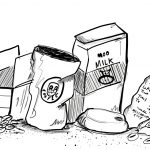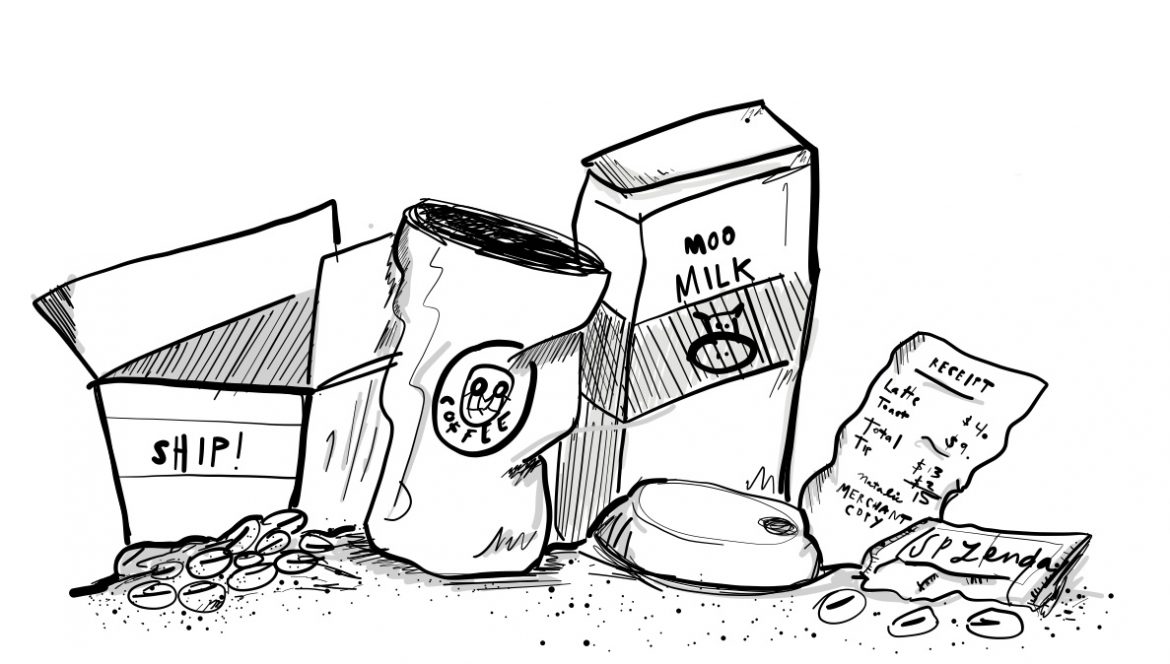

Susanne Collins, a barista at Joe Coffee in Philadelphia’s Rittenhouse Square, has only worked in specialty coffee since last spring. But despite her short tenure, she has already had a major impact on her company, championing a push to reduce waste both inside the cafe and out.
“I began seriously reducing my waste earlier this year after being inspired by my fantastic friend Emily of Born Lucky Studios,” says Collins, who also works as a performing artist at Plant Me Here and Miniature Refrigerator Operator. “I did a lot of research and it was like a switch got flipped inside my brain. I started seeing waste everywhere and vowed to reduce my footprint. Although I’ve had good and bad moments since then, I’ve drastically reduced the amount of waste I produce and continue to find new and exciting ways to do so.”
While her efforts to reduce her own waste as an individual at home and work have seen dramatic results, she’s careful to note that waste reduction goes deeper than just the actions of individuals. “There are two avenues to being sustainable in a cafe setting: individual efforts and system-wide efforts,” she says. “Individual efforts are ways you, as a single person, can reduce your waste. At Joe Coffee, I have my own reusable cup that I drink out of, with a lid and a metal reusable straw to comply with health code. On an individual level, that keeps hundreds of single-use cups out of landfills each year. Conservatively, it comes out to around 500 cups saved each year for an average barista. If a whole staff makes the shift, that’s thousands of cups each year.”
Collins also emphasizes the role that customer service can play in conserving resources. “I make sure to always ask a customer if their drink is for here or to go so that no one gets a paper or plastic cup when they could be drinking out of our reusable ceramic or glass cups,” she says. “I know it can get frustrating to have to clean extra dishes at the end of the day, but if it saves one cup that will sit in a landfill for centuries, isn’t it worth it?” Since Joe Coffee offers a discount to people who bring their own cups, she also makes sure to thank customers who bring them and know that they’re getting a discount, which hopefully incentivizes them to bring back their reusable cup next time they come in.
Then there are the systemic changes that happen within a cafe’s infrastructure. “For some baristas, change within a company—particularly a chain with certain aesthetic consistencies among locations—seems impossible, but you never know what’s possible until you try,” says Collins. “I urge those who would like to see systematic changes to touch base with a manager they trust to see what’s on the table.”
Systemic change options are myriad, and Collins breaks down a few of them:
- Give discounts to customers who bring their own cups
- Clearly mark trash, recycling, and compost bins with what belongs in each
- Only provide single-use objects like straws or paper receipts if asked
- Leave sustainability notes near all single-use objects, encouraging patrons to only take them if they need them
- Use sugar bowls or larger refillable sugar containers over single-use sugar or sweetener packets
- Order paper and plastic products from eco-friendly companies (for example, make sure your company’s toilet paper packaging is paper and not plastic)
- Find out how composting works in your city and make it happen. If your city doesn’t have free composting services, use a paid service or donate your compost to a local farm
“The great thing about reducing waste is that it often reduces costs as well,” she adds. “More reusable mugs means less spent on ordering cups. A sign near the napkins to remind patrons to only take however many they need brings down the cost of wasted napkins.” So cafe conservation isn’t an act of environmental charity; it has concrete and immediate value for companies who engage in it.
Collins also wants to offer a message of hope for waste-aware cafe workers who feel powerless. “It can be really disheartening sometimes to be a waste-aware person working in coffee,” she says. “So much waste is a byproduct of living in a society that prioritizes convenience. Changing trash bag after trash bag full of discarded paper and plastic cups, many of which will be on this earth far longer than I will, can get me down in the dumps. Rather than focus on that, I like to celebrate the good choices. Instead of thinking how much waste your cafe is making, think about the thousands of cups that aren’t in a landfill due to you and your coworkers bringing your reusable cups. Or the farmer and their crops that are thriving due to your compost.”
Collins’s work on waste reduction in the cafe sets a great example that’s easy for others to follow. Cafe waste is hard to ignore, and as a field directly hit by climate change, something we actually can’t afford to ignore. Luckily, we don’t have to, since, as Collins demonstrates, eliminating unnecessary cafe waste can actually save money. In an era where many companies are looking for ways to make an impact on climate change, these strategies can provide a crucial starting point for those who are ready to do more with less.
RJ Joseph (@RJ_Sproseph) is a freelance journalist, publisher of Queer Cup, and coffee professional based in the Bay Area. Read more RJ Joseph for Sprudge.
The post How Coffee Bars Are Wasting Less appeared first on Sprudge.
from RSSMix.com Mix ID 8200593 http://sprudge.com/how-to-make-your-cafe-more-waste-aware-easy-ideas-to-implement-now-126638.html
No comments:
Post a Comment